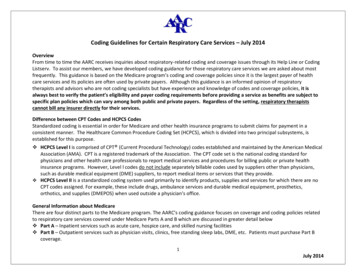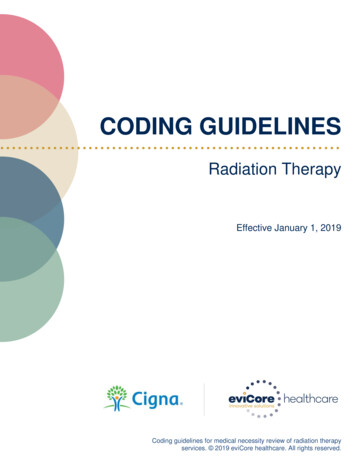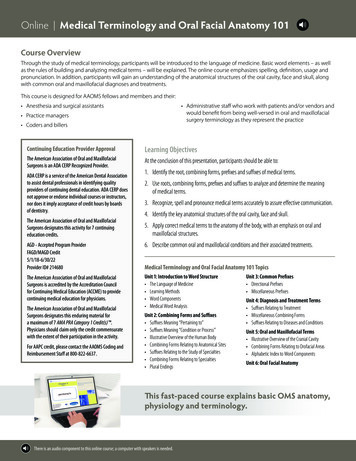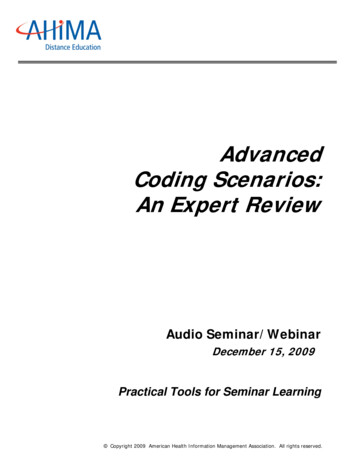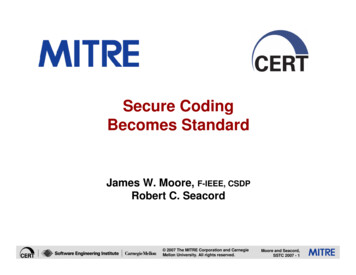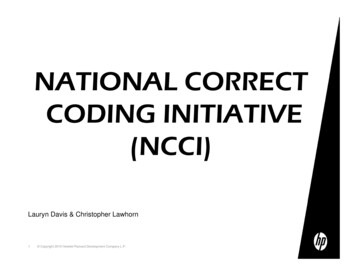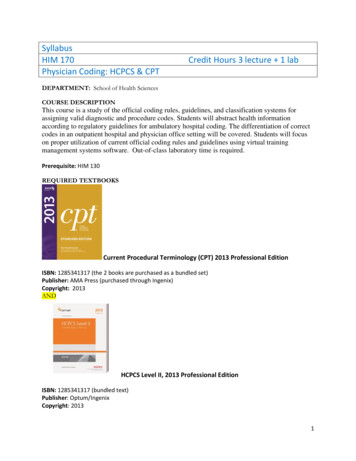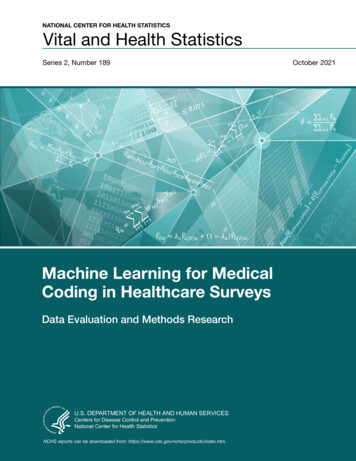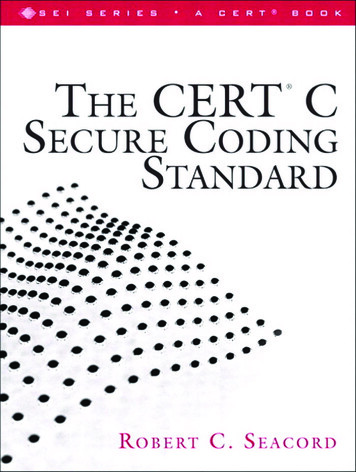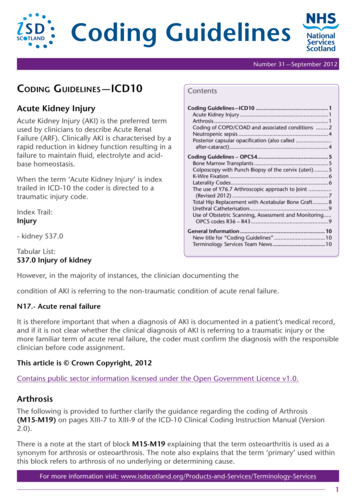
Transcription
Coding GuidelinesNumber 31 — September 2012Coding Guidelines — ICD10Acute Kidney InjuryAcute Kidney Injury (AKI) is the preferred termused by clinicians to describe Acute RenalFailure (ARF). Clinically AKI is characterised by arapid reduction in kidney function resulting in afailure to maintain fluid, electrolyte and acidbase homeostasis.When the term ‘Acute Kidney Injury’ is indextrailed in ICD-10 the coder is directed to atraumatic injury code.Index Trail:Injury- kidney S37.0Tabular List:S37.0 Injury of kidneyContentsCoding Guidelines — ICD10.1Acute Kidney Injury.1Arthrosis.1Coding of COPD/COAD and associated conditions .2Neutropenic sepsis.4Posterior capsular opacification (also called.after-cataract).4Coding Guidelines – OPCS4.5Bone Marrow Transplants.5Colposcopy with Punch Biopsy of the cervix (uteri).5K-Wire Fixation.6Laterality Codes.6The use of Y76.7 Arthroscopic approach to Joint.(Revised 2012).7Total Hip Replacement with Acetabular Bone Graft.8Urethral Catheterisation.9Use of Obstetric Scanning, Assessment and Monitoring.OPCS codes R36 – R43.9General Information.10New title for “Coding Guidelines”.10Terminology Services Team News.10However, in the majority of instances, the clinician documenting thecondition of AKI is referring to the non-traumatic condition of acute renal failure.N17.- Acute renal failureIt is therefore important that when a diagnosis of AKI is documented in a patient’s medical record,and if it is not clear whether the clinical diagnosis of AKI is referring to a traumatic injury or themore familiar term of acute renal failure, the coder must confirm the diagnosis with the responsibleclinician before code assignment.This article is Crown Copyright, 2012Contains public sector information licensed under the Open Government Licence v1.0.ArthrosisThe following is provided to further clarify the guidance regarding the coding of Arthrosis(M15-M19) on pages XIII-7 to XIII-9 of the ICD-10 Clinical Coding Instruction Manual (Version2.0).There is a note at the start of block M15-M19 explaining that the term osteoarthritis is used as asynonym for arthrosis or osteoarthrosis. The note also explains that the term ‘primary’ used withinthis block refers to arthrosis of no underlying or determining cause.For more information visit: ogy-Services1
Coders are advised to always default to unspecified forms of these conditions (.9) in cases wherethe clinician has not identified an underlying cause.Within the ICD-10 Alphabetical Index, the term ‘primary’ is an essential modifier which must bepresent in the clinical statement to enable coders to assign a code for a specific primary arthrosis.Where the modifier ‘primary’ is not included in the diagnostic statement, the coder must default tothe .9 unspecified code from the relevant ICD-10 category.Example:Bilateral osteoarthritis of the knees (gonarthrosis).Index Trail:Gonarthrosis M17.9Tabular List:M17.9 Gonarthrosis, unspecifiedRationale: The fact that the gonarthrosis is bilateral does not change the code assignment in thiscase. It is not stated that the gonarthrosis is ‘primary’, which as indicated above must be present inthe diagnostic statement for the code M17.0 Primary gonarthrosis, bilateral to be assigned.The same rule applies for all other types of osteoarthritis/ arthrosis.Clinical Coding Departments need to work closely with their clinicians to ensure that the precisediagnosis is captured to enable the assignment of the appropriate ICD-10 codes. It is not theresponsibility of the clinical coding professional to make a clinical judgement on the type ofarthrosis a patient has. The type of arthrosis is a clinical decision, and therefore the relevantinformation, or confirmation as to whether the condition can be described as ‘primary’, must beaccurately documented in the patient medical record.This article is Crown Copyright, 2012Contains public sector information licensed under the Open Government Licence v1.0.Coding of COPD/COAD and associated conditionsIn Coding Guidelines No.22, March 2008, we published a table to help coders assign theappropriate ICD10 codes for COPD/COAD with associated conditions and to ensure consistency inthe recording of these conditions. A new entry has been added to this table; Infective exacerbationof asthma, patient known COAD/COPD.This should be coded to J45.9 J22.X J44.9or J46.X J22.X J44.92
The table is reprinted below with the new entry.COPD/COADDiagnosisCOPD/COADCOPD/COAD with chest infectionCOPD/COAD with exacerbationCOPD/COAD with acute bronchitisCOPD/COAD with bronchitis (15 years and above)COPD/COAD with bronchitis and chest infectionCOPD/COAD with bronchitis NOSCOPD/COAD with chronic bronchitisCOPD/COAD with asthmaCOPD/COAD with acute asthmaCOPD/COAD with status asthmaticusCOPD/COAD with emphysemaCOPD/COAD with pneumonia, unspecifiedCOPD with haemophilus influenzae present in sputumChest infectionChest infection with acute bronchitisChest infection with bronchitis NOSChest infection with chronic bronchitisChest infection with cystic fibrosisChest infection with emphysemaChest infection, COPD and emphysemaChest infection with lower lobe consolidation on X-rayChest infection, J44.9J45.9 and J44.9J46.X and J44.9J43.9J18.9 and J44.0J44.0 and B96.3J22.XJ20.J40.X and J22.X(J41.- or J42.-) and J22.XE84.0J43.9 and J22.XJ44.0 and J43.9J18.1J22.X and I50.1 Sequencing isdependent on the main conditiontreatedChronic obstructive bronchitis with acute exacerbation J44.1URTI (Upper respiratory tract infection) with COPDJ44.1 and J06.9(Acute) exacerbation of asthmaJ45.9Infective exacerbation of asthma(J45.9 or J46.X) and J22.XInfective exacerbation of asthma with status asthmaticus J46.X and J22.XInfective exacerbation of asthma, patient known COAD/ J45.9 J22.X J44.9 orCOPDJ46.X J22.X J44.9(Above table adapted and modified from table published in Connecting for Health ICD10 ClinicalCoding Instruction Manual Version 2.0, February 2007 and Connecting for Health, Coding ClinicMarch 2012)Please note that previous guidance (Coding Guidelines No.4 September 1999 and No.8 February2001) still applies.This article is Crown Copyright, 2012Contains public sector information licensed under the Open Government Licence v1.0.3
Neutropenic sepsisNeutropenic sepsis develops due to a low white blood cell level, especially the type calledneutrophils which fight bacterial infections.Clinical input has confirmed that during treatment of neutropenic sepsis it is the sepsis that is themain condition treated rather than the neutropenia.Based on this information, the correct ICD-10 codes and sequence for a stated diagnosis ofneutropenic sepsis are:A41.- Other septicaemia(Fourth character code assignment will depend on whether or not the specific organism has beenidentified)D70.X AgranulocytosisIf the responsible consultant has confirmed that neutropenic sepsis was due to a drug then anexternal cause code from Chapter XX must be assigned in addition.This article is Crown Copyright, 2012Contains public sector information licensed under the Open Government Licence v1.0.Posterior capsular opacification (also called after-cataract)Posterior capsular opacification (also called after-cataract) may develop in some patients followingcataract surgery. Over time the part of the lens capsule holding the prosthetic lens in place canthicken, resulting in symptoms similar to those found in cataracts, such as hazy vision and poornight vision.The appropriate ICD-10 code for posterior capsular opacification is:H26.4 After-cataractThis article is Crown Copyright, 2012Contains public sector information licensed under the Open Government Licence v1.0.4
Coding Guidelines – OPCS4Bone Marrow TransplantsUpdate to article in Coding Guidelines No.23 September 2008, entitled “Peripheral Stem CellProcedures: Amendment to Previous Guidance”.When bone marrow transplants occur the coder needs to be clear whether they are coding aharvest/donation or a graft, AND whether the patient having the bone marrow removed is to bethe potential recipient of the bone marrow or not.The following chart aims to simplify this and supersedes guidance previously issued in CodingGuidelines No. 23, September 2008, published as part of a list of haematological procedures.Patient as the PotentialRecipient (Autologous)Patient is donating bonemarrow to another personHarvest/donationW35.8 Y66.7GraftW34.1Recipient (Autologous)X46.1 site ofdonationRecipient – not the donating W34.2-.9patient (Allograft)RationaleX46.1 has to be used for the donation for a non-autologous transplant because W35.8 is atherapeutic puncture of bone, and this would not be therapeutic to the donor. The trail isDonation Bone Marrow X46.1. Also where there is an autologous transplant taking place theextraction of the bone marrow would generally be described as a harvest of bone marrow ratherthan a donation. The trail is Harvest Bone Marrow Y66.7Colposcopy with Punch Biopsy of the cervix (uteri)A colposcopy is a diagnostic procedure which involves visual examination of the vagina and thecervix of the uterus using a colposcope.During colposcopy a speculum is inserted into the vagina to hold it open and a colposcope(a magnifying instrument that has a light source attached to it and looks similar to a pair ofbinoculars) is used to examine the cells of the cervix. If abnormal cells are found a biopsy may betaken from the cervix.A colposcope is not an endoscope and it does not touch or go inside the vagina, therefore theguidance for the coding of endoscopic procedures does not apply.When a punch biopsy of the cervix is carried out during a colposcopy examination, this must becoded using the following OPCS-4 codes:Q03.4 Punch biopsy of cervix uteriQ55.4 Colposcopy of cervixIncludes: Colposcopy NECThis article is Crown Copyright, 2012Contains public sector information licensed under the Open Government Licence v1.0.5
K-Wire FixationKirschner wires (K-wires) are steel wires frequently used to hold fragments of bone in position inthe treatment of bone fractures.Medical documentation and procedure notes do not usually clarify whether K-wire fixation shouldbe classified as a rigid or flexible form of internal fixation.In the term “flexible fixation”, the word flexible means that the implant can adapt to a path bychanging direction without damage to the internal structure. Kirschner wires (K-wires) may bebent, and whilst this changes the internal properties of the K-wire, this is not because it is flexiblebut because force has been applied. K-wire fixation is always a form of rigid fixation.The OPCS-4 code assignment may vary depending on the type of reduction performed, forexample primary, secondary, closed, open, etc.Example:Primary closed reduction and K-wire fixation of right sided fracture of lower end of radius,performed under image intensifier:W24.2 Closed reduction of fracture of long bone and rigid internal fixation NECZ70.5 Lower end of radius NECThis guidance is only relevant where coders have a choice of using a rigid or flexible fixation codeas in the W24.- rubric. Often the fixation within the OPCS classification is not further defined asflexible or rigid, for example W20.- where the extramedullary fixation is classified by type of fixatorrather than whether it is flexible or not.Note that K-wires may also be used to augment anchorage of cerclage wires and in skeletaltraction; in such instances the K-wires do not require coding in addition.This article is Crown Copyright, 2012Contains public sector information licensed under the Open Government Licence v1.0.Laterality CodesWhere space is available on the SMR, laterality (Z94.-) should be recorded where appropriate toreflect the side of the body on which the procedure/intervention was carried out.Where there is a conflict over selection of supplementary codes, the general rule is that a ‘Y’ codewould take precedence over a ‘Z’ code, except in Chapter W, where the Orthopaedic specialistsrequire the bone/joint and/or laterality in preference to any ‘Y’ code.Example 1:Excision of left kidney:M02.5 Nephrectomy NECZ94.3 Left sided operationRationale: There is no supplementary information about the method of procedure being carriedout and the title of the code includes the organ, therefore the laterality code can be added.Example 2:Primary suture of laceration to skin on the left side of the back:S42.1 Primary suture of skin NECZ49.4 Skin of back6
Rationale: There is no supplementary information about the method of procedure being carriedout, but the Site code is added to be more specific about the area of skin. There is no space toadd laterality.Example 3:Failed laparoscopic right nephrectomy – converted to open procedure.M02.5 Nephrectomy NECY71.4 Failed minimal access approach converted to openRationale: There is a requirement to add a supplementary code to show the change in themethod of operation. There is no space to add laterality.Example 4:Endoscopic drainage of cyst of right ovaryQ49.3 Endoscopic drainage of cyst of ovaryZ94.2 Right sided operationRationale: The supplementary information about the method of procedure is included in the maincode title, as is the name of the organ. There is therefore space to add the laterality code.Example 5:Tension band wiring of fracture of right patella.W21.4 Primary intra-articular fixation of intra-articular fracture of bone necZ78.7 PatellaRationale: The main operation code does not record information about the site of the operation,therefore the supplementary code gives the bone involved and there is no space to recordlaterality.The use of Y76.7 Arthroscopic approach to joint (Revised 2012)Addition of code W42.6 to list.The previous guideline ‘Arthroscopic Procedures’ Coding Guidelines No. 20, June 2007 stated thatY76.7 should not be used in Scotland.Since then a number of new, specific codes have been introduced (in OPCS4.5, April 2009) whichhave given rise to a number of requests to use Y76.7.The Clinical Coding Review Group has agreed that Y76.7 may be used with the following list ofcodes when the relevant procedures are performed arthroscopically:W42.6 Arthrolysis of Total Prosthetic Replacement of Knee JointW78.1 Release of Contracture of Shoulder JointW78.2 Release of Contracture of Hip JointW78.3 Release of Contracture of Knee JointW78.5 Release of Contracture of Elbow JointO27.2 Repair Capsule and Anterior and Posterior Labrum for Stabilisation ofGlenohumeral JointO27.3 Repair Capsule and Anterior Labrum for Stabilisation of Glenohumeral JointO27.4 Repair Capsule and Posterior Labrum for Stabilisation of Glenohumeral JointO29.1 Subacromial DecompressionT79.1 Plastic Repair of Rotator Cuff of Shoulder NECT79.3 Revisional Repair of Rotator Cuff NECT79.4 Plastic Repair of Multiple Tears of Rotator Cuff of ShoulderT79.5 Revisional Repair of Multiple Tears of Rotator Cuff of Shoulder7
V21.8 Other specified operations on temporomandibular joint (for temporomandibulararthroscopy)The use of Y76.7 with any of the above codes will of course prevent the recording of laterality.Y76.7 should not be used with any other codes. This list may be augmented in the future.Total Hip Replacement with Acetabular Bone GraftDuring most total hip replacement procedures, bone chippings produced from bone reamedfrom the patient’s femur are used to pack and secure a prosthetic joint replacement, providingadditional stability of the joint implant. This type of method is considered to be an integralpart of the procedure and therefore does not require coding in addition to the prosthetic jointreplacement.Example 1:Primary uncemented left total hip replacement, the joint implant was packed and secured usingbone chippings from the reamed bone of the patient’s femur:W38.1 Primary total prosthetic replacement of hip joint not using cementZ94.3 Left sided operationRationale: As the bone chippings are used as a part of the procedure to help secure the hipreplacement, it is not appropriate to assign a code for the bone chippings in addition.However, in other types of total hip replacements, and where there is evidence documented ofextensive acetabular bone loss, an acetabular bone graft (using either morcellised bone or boneblock), will be performed in addition to the total hip replacement. The acetabular bone graft isconsidered to be in addition to the joint replacement procedure, and therefore a code for the bonegraft must be assigned in addition to the code for the total hip replacement.The appropriate OPCS-4 code to assign for the acetabular bone graft will depend on whether it isan ‘autograft’ or ‘allograft’ of bone. Whenever an autograft is performed, the bone is taken fromone part of the body and is placed in another site on the same individual. This requires a harvestcode to be assigned in addition to the code for the total hip replacement.Example 2:Primary uncemented left total hip replacement with morcellised autograft of bone to largeacetabular defect. Bone harvested from left iliac crest.W38.1 Primary total prosthetic replacement of hip joint not using cementZ94.3 Left sided operationW31.4 Cancellous chip autograft of boneZ75.6 AcetabulumW08.8 Other Specified Excision of BoneY66.3 Harvest of bone from iliac crestRationale: The bone graft material in this procedure is an autograft which was harvested from theiliac crest of the patient, and therefore it is appropriate to assign codes to identify the autograftand harvest in addition to the code for the total hip replacement.Example 3:Primary uncemented left total hip replacement with acetabular bone graft using bone blockobtained from the bone bank to address the defect in the left acetabulum.8
W38.1 Primary total prosthetic replacement of hip joint not using cementZ94.3 Left sided operationW32.2 Allograft of bone NECZ75.6 AcetabulumRationale: It is appropriate to assign a code to identify the allograft of bone, as the bone graftwas obtained from the bone bank. Where an allograft or xenograft has been donated from abone bank, or supplied from a different individual, it is not appropriate to assign a harvest code inaddition, as the graft was not harvested from the original patient.Any uncertainty as to whether the joint replacement involves a bone graft, or a packing using bonechippings, must be referred back to the responsible consultant for clarificationThis article is Crown Copyright, 2012Contains public sector information licensed under the Open Government Licence v1.0.Urethral CatheterisationQuestionIs it appropriate to assign the OPCS-4 code M47.9 Unspecified urethral catheterisation of bladderin instances where an inpatient who is being treated for some other condition goes on to developurinary retention during their hospital stay, and is subsequently treated by urethral catheterisation?AnswerIt is appropriate to assign the OPCS-4 code M47.9 Unspecified urethral catheterisation of bladderwhere it is clearly documented in the patient’s medical record that during their hospital stay fortreatment of another condition the patient also developed urinary retention, which was treatedwith catheterisation. This is because the catheterisation would not be considered to be part of thepatient’s routine care for the other condition.However, it is not appropriate to assign the OPCS-4 code M47.9 Unspecified urethralcatheterisation of bladder in circumstances where the catheterisation is performed routinely as partof, or following, a procedure.This article is Crown Copyright, 2012Contains public sector information licensed under the Open Government Licence v1.0.Use of Obstetric Scanning, Assessment and Monitoring OPCS codes R36 – R43It has been agreed that obstetric scanning, assessment and monitoring codes should be treated inthe same way as other scans.Therefore the table produced in the article entitled “Coding of “non-operative” interventions/procedures (imaging, injections, infusions, x-rays, etc.) on SMR01 and SMR02”, in CodingGuidelines No.22 March 2008 and updated in Coding Guidelines No.25 April 2010, now containsguidance on the coding of obstetric scans, assessments and monitoring.This decision requires that an amendment be made to the table referred to above, to incorporatecodes R36- R43.The updated table is printed below.9
Intervention/procedurecodeGeneral GuidanceU01-U40R36 – R43X28-X39X44, X48-X58X65X60-X62, X66, X67.-, X68.X70, codeGuidance if Elective admission(inpatient/day case) specifically forthis intervention/procedureCodeCodeCodeCodeCodeNot mandatory to codeNot mandatory to codeNot mandatory to codePLEASE NOTE THAT ALL NEW GUIDANCE IN THIS EDITION APPLIES TO ALL DISCHARGES ONAND AFTER 1ST OCTOBER 2012.General InformationNew title for “Coding Guidelines”Please note that as of March 2013, the title of this publication will change to “Scottish ClinicalCoding Standards”.Terminology Services Team NewsEsther Morris has left the Terminology Services Team to take up a new role in ISD. We wish her wellin her new post. Notification of Esther’s replacement will be issued in due course. National Services Scotland 2012. You can copy or reproduce the information in thisdocument for use within NHSScotland and for non-commercial educational purposes. Use ofthis document for commercial purposes is permitted only with the written permission of NSS.ContactPlease note that the Terminology Advisory Service Telephone Number is0131 275 7283.The number is manned Tuesday to Thursday from 09.00 to 17.00 hrs.The link for previous coding guidelines online is: ogy-Services/Clinical-Coding-Guidelines10
trailed in ICD-10 the coder is directed to a traumatic injury code. Index Trail: Injury - kidney S37.0 Tabular List: . Diagnosis Code(s) COPD/COAD J44.9 COPD/COAD with chest infection J44.0 COPD/COAD with exacerbation J44.1 COPD/COAD with acute bronchitis J44.8 COPD/COAD with bronchitis (15 years and above) J44.8 .

